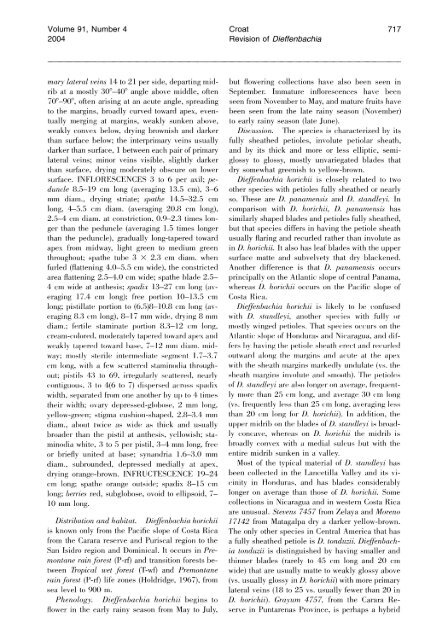l - CNCFlora
l - CNCFlora
l - CNCFlora
You also want an ePaper? Increase the reach of your titles
YUMPU automatically turns print PDFs into web optimized ePapers that Google loves.
Volume 91, Number 4<br />
2004<br />
Croat<br />
Revision of Dieffenbachia<br />
mary lateral veins 14 to 21 per side, departing mid- but flowering collections have also been seen in<br />
rib at a mostly 30°-40° angle above middle, often September. Immature inflorescences have been<br />
70°-90°, often arising at an acute angle, spreading seen from November to May, and mature fruits have<br />
to the margins, broadly curved toward apex, even- been seen from the late rainy season (November)<br />
tually merging at margins, weakly sunken above, to early rainy season (late June).<br />
weakly convex below, drying brownish and darker Discussion. The species is characterized by its<br />
than surface below; the interprimary veins usually fully sheathed petioles, involute petiolar sheath,<br />
darker than surface, 1 between each pair of primary and by its thick and more or less elliptic, semilateral<br />
veins; minor veins visible, slightly darker glossy to glossy, mostly unvariegated blades that<br />
than surface, drying moderately obscure on lower dry somewhat greenish to yellow-brown.<br />
surface. INFLORESCENCES 3 to 6 per axil; pe- Dieffenbachia horichii is closely related to two<br />
duncle 8.5-19 cm long (averaging 13.5 cm), 3-6 other species with petioles fully sheathed or nearly<br />
mm diam., drying striate; spathe 14.5-32.5 cm so. These are D. panamensis and D. standleyi. In<br />
long, 4-5.5 cm diam. (averaging 20.8 cm long), comparison with D. horichii: D. panamensis has<br />
2.5-4 cm diam. at constriction, 0.9-2.3 times lon- similarly shaped blades and petioles fully sheathed,<br />
ger than the peduncle (averaging 1.5 times longer but that species differs in having the petiole sheath<br />
than the peduncle), gradually long-tapered toward usually flaring and recurled rather than involute as<br />
apex from midway, light green to medium green in D. horichii. It also has leaf blades with the upper<br />
throughout; spathe tube 3 x 2.3 cm diam. when surface matte and subvelvety that dry blackened.<br />
furled (flattening 4.0-5.5 cm wide), the constricted Another difference is that D. panamensis occurs<br />
area flattening 2.5-4.0 cm wide; spathe blaele 2.5- principally on the Atlantic: slope of central Panama,<br />
4 cm wide at anthesis; spadix 13-27 cm long (av- whereas D. horichii occurs on the Pacific slope of<br />
eraging 17.4 c m long); free portion 10-13.5 ( m Costa Rica.<br />
long; pistillate portion to (6.5)8-10.8 cm long (av- DieJ/en/)lchi(l horichii is likely to I)e (onfuse(l<br />
eraging 8.3 c m long), 8-17 mm wide, drying 8 mln with D. .st(ln(lleyi: another sr)ee ies with fully or<br />
diam.; feltile staminate )ortion 8. 3-12 cm long, mostly winpr,(l Xetioles. That sI)ee ies oe ( urs; on the<br />
c rearm-( olore(le mo(lerately tapere(l towar(l aI)ex an(l Atlantie slole of Hon(luras an(l Nie arapr,ua, an(l (lifweakly<br />
talxere(l towar(l baxe, 7-12 mln (liam. mi(l- fers lxy 11avinpr, the [)etiole slleatll eree t an(l re( urle(l<br />
way; mostly xtel ile interlne(liclte segnlerlt 1 .7--3.7 outwar(l alont, the margins an(l a(ute at the ay)ex<br />
cm long, witll a few xcattele(l xtamino(lia through- with the sheath margins marke(lly un(lulate (vs. tlle<br />
out; pixtilx 4.-3 to 69, irregulal Iy scattere(l, neal Iy sheath malgins illvolute an(l smooth). 'I'he letioles<br />
contiguouse .-3 to 4(6 to 7) (lisl)erse(l acloxs xla(lix of l). .ft(lMdleyi are also longer on average, frequentwidth?<br />
xelalate(l from one another by ul) to 4 tinlex ly more than 25 c m long, an( average 3() (m long<br />
their width; ovary depresse(l-globoxeX 2 mm long, (vs. fre(uently 1ess than 25 c rll long, averaging less<br />
yellow-green; xtigma cushion-S;hape(l, 2.8-3.4 mm than 2() ( m long for l). horichii). Tn a(i(itionX the<br />
diam., about twice as wide ax thick and usually upper midrib on the l)lades of D. stclol(lleyi is broa(lbroader<br />
than the pistil at anthesix, yellowish; xta- ly concave, whereas on D. horichii the midril) is<br />
minodia white, 3 to 5 per pistil, 3-4 mm long, free l)roadly (onvex with a medial sulcus lout with the<br />
or briefly united at base; synan(lria 1.6-3.0 mm entire midrib sunken in a valley.<br />
diam., subrounde(l, depressed medially at apex, Most of the typical material of D. stan(lleyi has<br />
drying orange-brown. INFRUCTESCENCE 19-24 been collected in the Lancetilla Valley and its vicm<br />
long; spathe orange outsi(le; spadix 8-15 cm cinity in HoncAllras, and has blades considerably<br />
long; berries red, subglobose, ovoid to ellipsoid, 7- longer on average than those of D. horichii. Some<br />
10 mm long.<br />
collections in Nicaragua and in western Costa Rica<br />
are unusual. Stevens 7457 from Zelaya and Moreno<br />
Distribution and habitat. Dieffenbachia horichii 17142 from Matagalpa dry a darker yellow-brown.<br />
is known only from the Pacific slope of Costa Rica The only other species in Central America that has<br />
from the Carara reserve and Puriscal region to the a fully sheathed petiole is D. tonduzii. Dieffenbach-<br />
San Isidro region and Dominical. It occurs in Pre- ia tonduzii is distinguished by having smaller and<br />
montane rain forest (P-rf) and transition forests be- thinner blades (rarely to 45 cm long and 20 cm<br />
tween Tropical wet forest (T-wf) and Premontane wide) that are usually matte to weakly glossy above<br />
rain forest (P-rf) life zones (Holdridge, 1967), from (vs. usually glossy in D. horichii) with more primary<br />
sea level to 900 m.<br />
lateral veins (18 to 25 vs. usually fewer than 20 in<br />
Phenology. Dieffenbachia horichii begins to D. horichii). Grayum 4757: from the Carara Reflower<br />
in the early rainy season from May to July, serve in Puntarenas Province, is perhaps a hybrid<br />
717

















